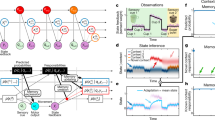Abstract
A previous study (Epstein, Kirshnit, Lanza, & Rubin, 1984) showed that pigeons that had acquired two relevant behaviors (pushing a box toward targets, and climbing onto a box and then pecking a small facsimile of a banana) could solve the classic box-and-banana problem. A human-like solution emerged as a result of the manner in which the two repertoires became interconnected moment-to-moment in time (Epstein et al., 1984; Epstein & Medalie, 1983). In the current experiment, a pigeon acquired three separate behaviors: (a) climbing, (b) pushing toward targets, and (c) pecking the banana. When the pigeon was confronted with the problem, a swift but erratic and not especially “insightful” solution emerged. Some simple principles shed light on the differences between the performances generated by the interconnection of two repertoires and the interconnection of three repertoires in this situation.
Similar content being viewed by others
References
CUMMING, W. W., & ECKERMAN, D. A. (1965). Stimulus control of a differentiated operant. Psychonomic Science, 3, 313–314.
DASHIELL, J. F. (1930). Direction orientation in maze running by the white rat. Comparative Psychology Monographs, 7.
DUNCKER, K. (1945). On problem-solving. Psychological Monographs, No. 270.
ELLEN, P. (1982). Direction, past experience, and hints in creative problem solving: Reply to Weisberg and Alba. Journal of Experimental Psychology: General, 111, 316–325.
EPSTEIN, R. (1981). On pigeons and people: A preliminary look at the Columban Simulation Project. The Behavior Analyst, 4(1), 43–55.
EPSTEIN, R. (1983). Resurgence of previously reinforced behavior during extinction. Behaviour Analysis Letters, 3, 391–397.
EPSTEIN, R. (1984a). Simulation research in the analysis of behavior. Behaviorism, 12(2), 41–59.
EPSTEIN, R. (1984b, September). A moment-to-moment account of the emergence of a novel performance. Invited address given at the meeting of the International Society for Comparative Psychology, Acapulco.
EPSTEIN, R. (1985). Extinction-induced resurgence: Preliminary investigations and possible applications. The Psychological Record, 35, 131–141.
EPSTEIN, R. (in press). Bringing cognition and creativity into the behavioral laboratory. In T. J. Knapp & L. Robertson (Eds.), Approaches to cognition: Contrasts and controversies. Hillsdale, NJ: Erlbaum.
EPSTEIN, R., KIRSHNIT, C., LANZA, R., & RUBIN, L. (1984). ‘Insight’ in the pigeon: Antecedents and determinants of an intelligent performance. Nature, 308, 1 March, 61–62.
EPSTEIN, R., LANZA, R. P., & SKINNER, B. F. (1980). Symbolic communication between two pigeons (Columba livia domestica). Science, 207, 543–545.
EPSTEIN, R., & MEDALIE, S. (1983). The spontaneous use of a tool by a pigeon. Behaviour Analysis Letters, 3, 241–247.
EPSTEIN, R., & SKINNER, B. F. (1981). The spontaneous use of a memorandum by pigeons. Behaviour Analysis Letters, 1, 241–246.
HULL, C. L. (1935). The mechanism of the assembly of behavior segments in novel combinations suitable for problem solving. Psychological Review, 42, 219–245.
HULL, C. L. (1952). A behavior system. New Haven, Ct: Yale University Press.
KÖHLER, W. (1925). The mentality of apes. New York: Routledge & Kegan Paul.
KOFFKA, K. (1924). The growth of the mind. London: Kegan Paul.
MAIER, N. R. F. (1929). Reasoning in white rats. Comparative Psychology Monographs, 6.
MAIER, N. R. F. (1931). Reasoning and learning. Psychological Review, 38, 332–342.
MAIER, N. R. F. (1932). The effect of cortical destruction on reasoning and learning in white rats. Journal of Comparative Neurology, 54, 45–75.
MIGLER, B. (1964). Effects of averaging data during stimulus generalization. Journal of the Experimental Analysis of Behavior, 7, 303–307.
YERKES, R. M. (1929). The great apes. New Haven, CT: Yale University Press.
Author information
Authors and Affiliations
Additional information
The work was supported in part by NIH Grant MH32628 to the Foundation for Research on the Nervous System.
Rights and permissions
About this article
Cite this article
Epstein, R. The Spontaneous Interconnection of Three Repertoires. Psychol Rec 35, 131–141 (1985). https://doi.org/10.1007/BF03394917
Published:
Issue Date:
DOI: https://doi.org/10.1007/BF03394917




